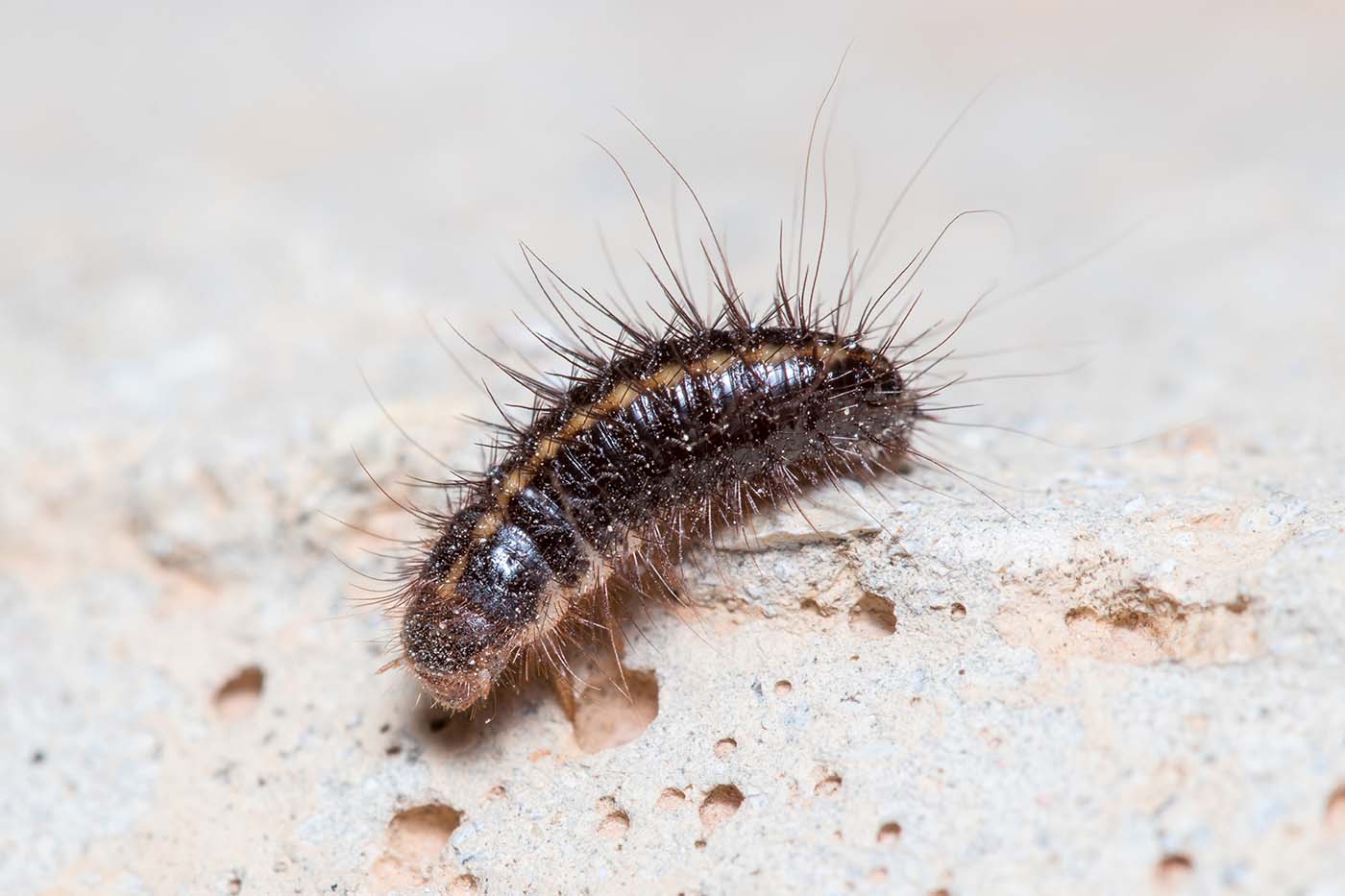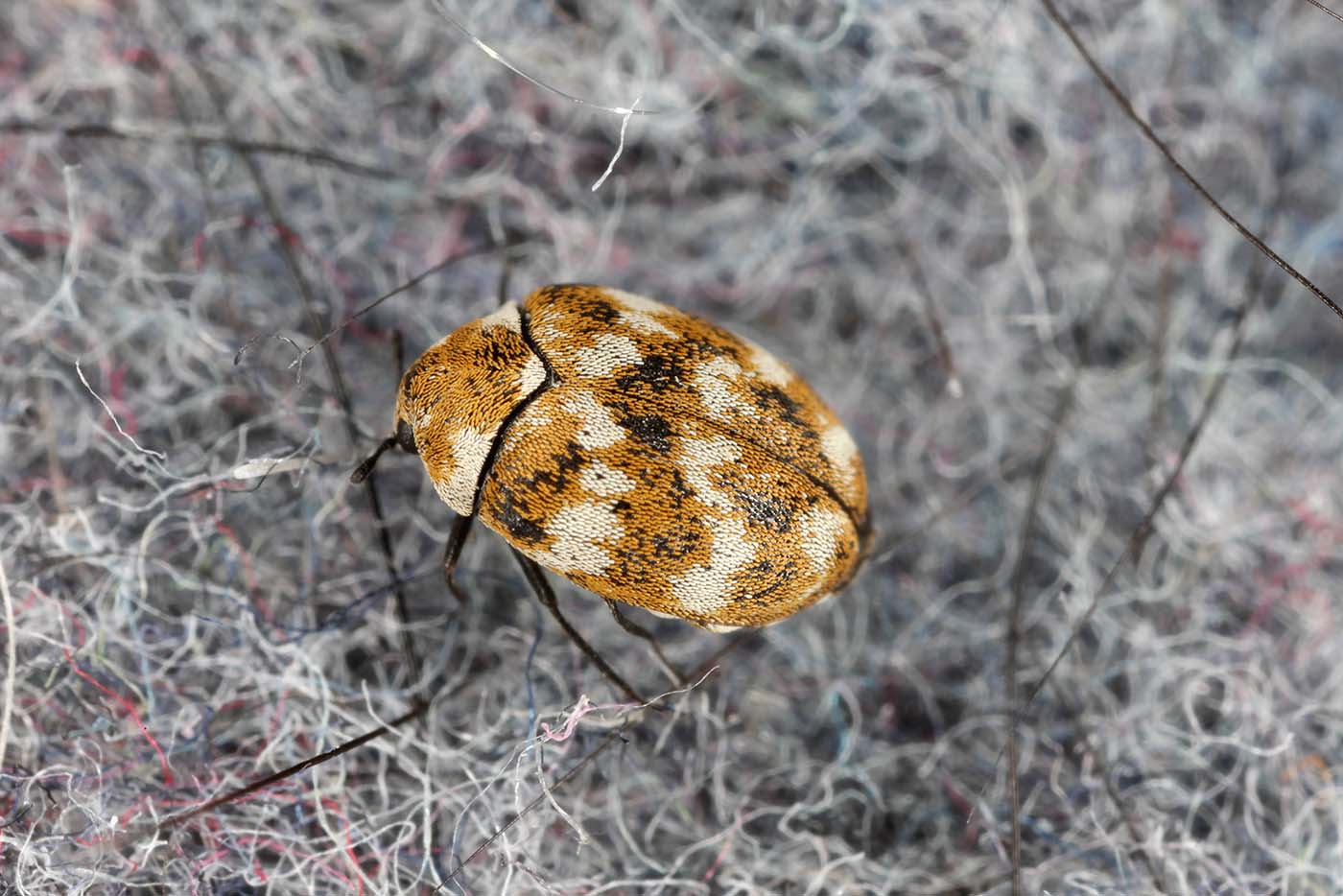Carpet Beetles
Carpet beetles are a common yet unwelcome pest found in homes across the UK. These tiny insects can cause significant damage to carpets, clothing, and other items made from natural fibres. In this article we aim to provide understanding of carpet beetles, their appearance, habitat, and feeding habits. Additionally, we’ll discuss the different varieties found in the UK, why they are considered pests, and offer guidance on how to spot and prevent carpet beetle infestations.
What Do Carpet Beetles Look Like?
Carpet beetles are small, oval-shaped insects, typically measuring between 2 to 5 millimetres in length. They have rounded, dome-shaped bodies covered in scales or hairs, with a colour pattern that varies depending on the species. Most carpet beetles have a combination of black, white, and brown or yellow scales, which create a mottled appearance. Adult carpet beetles have wings and are capable of flying, while their larvae, often referred to as “woolly bears,” are elongated, hairy, and brown or tan in colour.
There are several species of carpet beetles found in the UK, with the most common being:
- Varied carpet beetle (Anthrenus verbasci): This species has a mottled appearance, with scales in white, brown, and yellow arranged in a random pattern.
- Furniture carpet beetle (Anthrenus flavipes): Similar in appearance to the varied carpet beetle, this species has yellow and white scales with black crossbands.
- Black carpet beetle (Attagenus unicolor): The black carpet beetle is larger than other species, measuring up to 5 millimetres in length. It is entirely black, with a more elongated body shape.
Carpet beetles undergo a complete metamorphosis throughout their life cycle, consisting of four stages: egg, larva, pupa, and adult. Adult females lay clusters of eggs 20-100 at a time, which they lay near food sources, the eggs hatch into larvae that feed on natural fibres and materials containing keratin. The larval stage can last several months to over a year, depending on environmental factors. After reaching their maximum size, larvae enter the pupal stage, forming a cocoon and undergoing a significant transformation. Emerging as adults, carpet beetles feed on nectar and pollen, reproduce, and lay eggs to start the procreation cycle anew. This life cycle enables carpet beetles to adapt to various environments and infest homes if not effectively controlled.
 Do Carpet Beetles Bite?
Do Carpet Beetles Bite?
Carpet beetles do not bite humans or pets. However, some people may experience skin irritation or an allergic reaction when coming into contact with the hairs of carpet beetle larvae. This can result in red, itchy bumps or rashes that are sometimes mistaken for insect bites.
How to Spot an Infestation of Carpet Beetles
Detecting a carpet beetle infestation can be challenging due to their small size and discreet behaviour. However, there are a few tell-tale signs that can help you identify their presence in your home:
- Damage to carpets, upholstery, and clothing: Carpet beetles feed on natural fibres, leaving behind small, irregularly shaped holes in infested materials.
- Larvae and shed skins: Look for small, hairy larvae and their discarded skins in dark, secluded areas such as closets, drawers, or under furniture.
- Adult beetles: You may spot adult beetles near windows or light sources, as they are attracted to light.
Carpet beetles are highly adaptable insects that can thrive in a variety of environments. In their natural outdoor habitat, they are commonly found in bird nests, animal carcasses, and beneath tree bark. However, they readily invade human dwellings in search of food sources, making their way inside through cracks and crevices, or by hitching a ride on flowers, plants, or clothing. Once indoors, carpet beetles seek out dark, secluded areas where they can feed undisturbed, such as closets, attics, and storage spaces.
What Do Carpet Beetles Feed On?
Carpet beetles are attracted to natural fibres and materials containing keratin, a protein found in animal hair, feathers, and dead skin cells. Their diet includes:
- Wool, silk, and fur clothing or textiles
- Upholstered furniture made from natural fibres
- Carpets made from wool or other natural materials
- Taxidermy specimens
- Feathers, animal hair, and insect collections
- Dead insects, spiders, and other arthropods
What Causes Carpet Beetles?
Carpet beetles are attracted to homes that offer suitable food sources, such as carpets, clothing, and upholstered furniture made from natural fibres. They can enter your home through open windows and doors, cracks in walls or foundations, or hitch a ride on items brought indoors. Factors that can increase the risk of a carpet beetle infestation include:
- Poor housekeeping and hygiene: Accumulated dust, pet hair, and debris can provide sustenance for carpet beetles and their larvae.
- Access to natural fibres: Homes with a large number of natural fibre items, such as wool or silk carpets, clothing, and upholstery, are more susceptible to carpet beetle infestations.
- Bird nests and animal carcasses: The presence of bird nests or dead animals in close proximity to your home can attract carpet beetles, increasing the likelihood of an indoor infestation.
Preventing Carpet Beetle Infestations
Prevention is key to avoiding carpet beetle infestations. Implement the following measures to reduce the risk of these pests invading your home:
- Regular cleaning: Vacuum and clean your home regularly to remove dust, pet hair, and debris that may attract carpet beetles.
- Seal entry points: Caulk and seal cracks and crevices around windows, doors, and foundations to prevent carpet beetles from entering your home.
- Inspect items: Check second-hand furniture, clothing, or textiles for signs of carpet beetles before bringing them into your home.
- Store items properly: Keep clothing, textiles, and other natural fibre items in sealed plastic bags or containers to protect them from carpet beetles.
- Regularly inspect your home: Periodically check dark, secluded areas in your home for signs of carpet beetles or their larvae.
It should be remembered however, that open windows and doors potentially allows beetles into your home unchallenged.
Carpet Beetle Pest Control
Carpet beetles are a common pest in the UK, causing damage to carpets, clothing, and other natural fibre items. By understanding their appearance, habits, and preferred habitats, homeowners can take the necessary steps to spot and prevent carpet beetle infestations, ensuring their homes remain free from these unwelcome insects. If you have an infestation of Carpet Beetles we can help! At iX5 Pest Control we provide Pest Control Services throughout Northamptonshire and surrounding areas for both domestic and commercial environments. We provide a 7 day pest control service, and can arrange visits during evenings or weekends at no extra cost. Contact us now and our experts will be more than happy to help.

